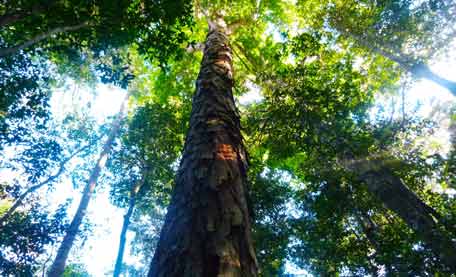
CO2 fertilization has prompted plants and trees to sprout extra green leaves.
Researchers find significant greening on Earth
There has been an increase in leaves on plants and trees on the Earth equivalent in area to two times the continental USA, a new study shows.
CO2 fertilization has prompted plants and trees to sprout extra green leaves which would fill nearly 4.4 billion large giant sequoia trees, researchers have found.
The significant greening of a quarter to one half of the Earth’s vegetated lands was shown by 33 years of data from NASA and National Oceanic and Atmospheric Administration satellite sensors.
The research was carried out by an international team of 32 authors from 24 institutions in eight countries, including the University of Exeter.
CO2 fertilization is the predominant reason why the Earth is greening. The study also identified climate change, nitrogen fertilization and land management as other, although less important, reasons.
Burning oil, gas, coal and wood for energy releases CO2 in to the air. The amount of CO2 in the air has been increasing since the industrial age and currently stands at a level not seen in at least half a million years. It is the chief culprit of climate change.
Every year, about one half of the 10 billion tons of carbon emitted in to the atmosphere from human activities remains temporarily stored, in about equal parts, in the oceans and plants.
Green leaves produce sugars using energy in the sunlight to mix carbon dioxide (CO2) drawn in from the air with water and nutrients pumped in from the ground. These sugars are the source of food, fibre and fuel for life on Earth. More sugars are produced when there is more CO2 in the air, and this is called CO2 fertilization.
Professor Stephen Sitch, Chair in Climate Change at the University of Exeter and co-author of the new study said: “Our findings explain how the observed greening of our planet is mainly due to the fertilisation effects of rising CO2 levels on plants.
“This helps to explain how plants today are able to mop up almost one third of human carbon dioxide emissions, and help mitigate climate change. Understanding the response of ecosystems to changing environmental conditions is of interest to us all.”
Professor Pierre Friedlingstein, the Chair of Mathematical Modelling of Climate Systems at Exeter and co-author of the study added: “The study offers a fascinating insight into the effect CO2 in the atmosphere is having on the planet.
“This of course doesn’t mean that additional CO2 in the atmosphere is beneficial – the threat of climate change is very real and our actions now will echo over generations. However, it does give us a greater understanding of the current effect on increasing CO2 on plant ecosystems at the scale of the whole planet.”
Professor Ranga Myneni of the Department of Earth and Environment at Boston University, USA, said: “We were able to tie the greening largely to the fertilizing effect of rising atmospheric CO2 concentration by tasking several computer models to mimic plant growth observed in the satellite data.”
Lead author Dr Zaichun Zhu, from Peking University, China, said: “The greening over the past 33 years reported in this study is equivalent to adding a green continent about two times the size of mainland USA, 18 million km2, and has the ability to fundamentally change the cycling of water and carbon in the climate system.”
The beneficial aspect of CO2 fertilization in promoting plant growth has been used to argue against cuts in carbon emissions to mitigate climate change, similar to those agreed at the 21st Conference of Parties meeting in Paris last year under the UN Framework on Climate Change.
Study author Dr. Philippe Ciais said: “The fallacy of the contrarian argument is two fold. First, the many negative aspects of climate change, namely global warming, rising sea levels, melting glaciers and sea ice, more severe tropical storms, etc. are not acknowledged. Second, studies have shown that plants acclimatize, or adjust, to rising CO2 concentration and the fertilization effect diminishes over time.”
The study recognises that CO2 fertilization is only one, albeit predominant, reason why the Earth is greening. It also identifies climate change, nitrogen fertilization and land management as other important reasons.”
Co-author Dr. Josep Canadell of the CSIRO Oceans and Atmosphere Division in Canberra, Australia and leader of the Global Carbon Project, said: “While the detection of greening is based on measurements, the attribution to various drivers is based on models, and these models have known deficiencies. Future works will undoubtedly question and refine our results.
Greening of the Earth and its Drivers is published in the journal Nature Climate Change.
Date: 26 April 2016